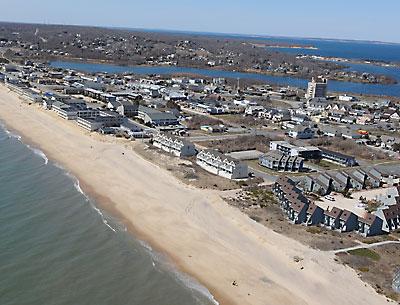Town Fails to Act on Erosion

After hearing 11 recommendations from an ad hoc committee on March 19 about ways to protect the Montauk ocean beach, the East Hampton Town Board seemed open to any or all of them. But at a work session on Tuesday, when erosion control was again on the agenda, the discussion bogged down, and the board ultimately dropped the issue without charting a course of action.
The committee had proposed short-term fixes that could begin immediately as well as longer-term plans that would require legislative action or make a slow difference over time. On Tuesday, some board members appeared ready to get down to the nitty gritty of how to begin.
Supervisor Bill Wilkinson had indicated general approval of the committee’s recommendations on March 19, saying, “Any of these things we can do, let’s get started.” In the interim, however, he and Councilwoman Theresa Quigley appear to have decided to push forward with only one: “dropping rocks” on the beach in downtown Montauk.
Two of the committee’s 11 recommendations concern temporarily allowing Montauk oceanfront property owners to install hard structures, such as buried rocks or concrete blocks, until longer-range solutions could be implemented. Because such structures are prohibited by the Local Waterfront Revitalization Program, however, the committee recommended that it be changed.
At Councilwoman Quigley’s request, John Jilnicki, the town attorney, described on Tuesday a process by which the board could bypass town law and the L.W.R.P altogether. He pointed out that under the existing code, creating a new Montauk beach according to an engineer’s design, which could be expected to withstand storms and erosion over a certain length of time, would be allowable only if done without installing rocks or other hard structures.
However, he said, the board could bypass the normal guidelines if it determined that certain conditions exist. One is that there “is no reasonable alternative to a proposed action,” he said. In addition, a supermajority vote, or majority-plus-one, would be required. The proposal was dropped when Ms. Quigley and Mr. Wilkinson found such a vote would not be forthcoming.
The idea is that the rocks, Ms. Quigley said, would be temporary, with sand covering such structures placed shoreward of the water line close to the foundations of beachfront motels threatened by the sea.
“So as not to waste time, would there be four votes?” she asked. “You’ll never get four votes to drop rock,” Mr. Wilkinson said, adding “I’ll vote for temporary.”
“Define temporary,” Councilwoman Sylvia Overby said. She and Councilman Peter Van Scoyoc said they could not give blanket approval to a shore-hardening plan and that specific information was needed. It was unclear how the other member of the board, Councilman Dominick Stanzione, would vote, although he noted that they had talked about “liberalizing emergency measures.”
The committee had suggested the board assess shore-hardening options, Mr. Van Scoyoc said, but that had not taken place. “I think there’s a whole lot of difference between having the Army Corps scientifically look at it, and having a motel owner saying, ‘let me drop cesspool rings,’ ” he said, referring to the owners of the Royal Atlantic Resort, who brought in concrete rings last year.
Various options that were discussed by the erosion committee, Mr. Van Scoyoc said, would have to be reviewed as to their efficacy to protect against different storms or categories of hurricanes. “It’s a false sense of security to say that dropping rock in front of the hotels is going to protect the Montauk downtown in the case of a hurricane,” he said.
“If your goal is to protect downtown Montauk, what will work?” Ms. Quigley asked him.
Mr. Wilkinson pressed board members about what would happen should the town get news that its requested $20 million in federal grants for shoreline work is coming through. “If the Army Corps and [Congressman Timothy] Bishop say next week that money is coming, will you vote to drop rock?” he asked.
“I would look at it. I haven’t seen a plan yet. Show me the plan. The Army Corps comes with a plan,” Mr. Van Scoyoc responded.
Mr. Stanzione tried to steer the conversation to other elements of the committee’s work. “Does the board want to discuss adopting any of the recommendations?” he asked.
“What good is it?” Ms. Quigley replied. “The committee recommended to this board — the board is not accepting them,” Mr. Wilkinson added.
“That’s not true,” Mr. Van Scoyoc said. “That’s one recommendation; there are 11 of them.”
“That is the most critical recommendation,” Ms. Quigley said.
Other recommendations outline a broad approach, both short-term and long-range, and include such things as creating what is called an engineered beach, establishing an erosion control tax district to pay for protection efforts, developing a public buyout plan for willing sellers of shoreline property, encouraging property owners and utilities in the downtown and Ditch Plain area to implement flood protection measures such as those outlined by the Federal Emergency Management Agency, and immediately beginning a beach “renourishment” process by bringing in sand.
Mr. Wilkinson dismissed them as akin to having children “throw sand on the beach.”
